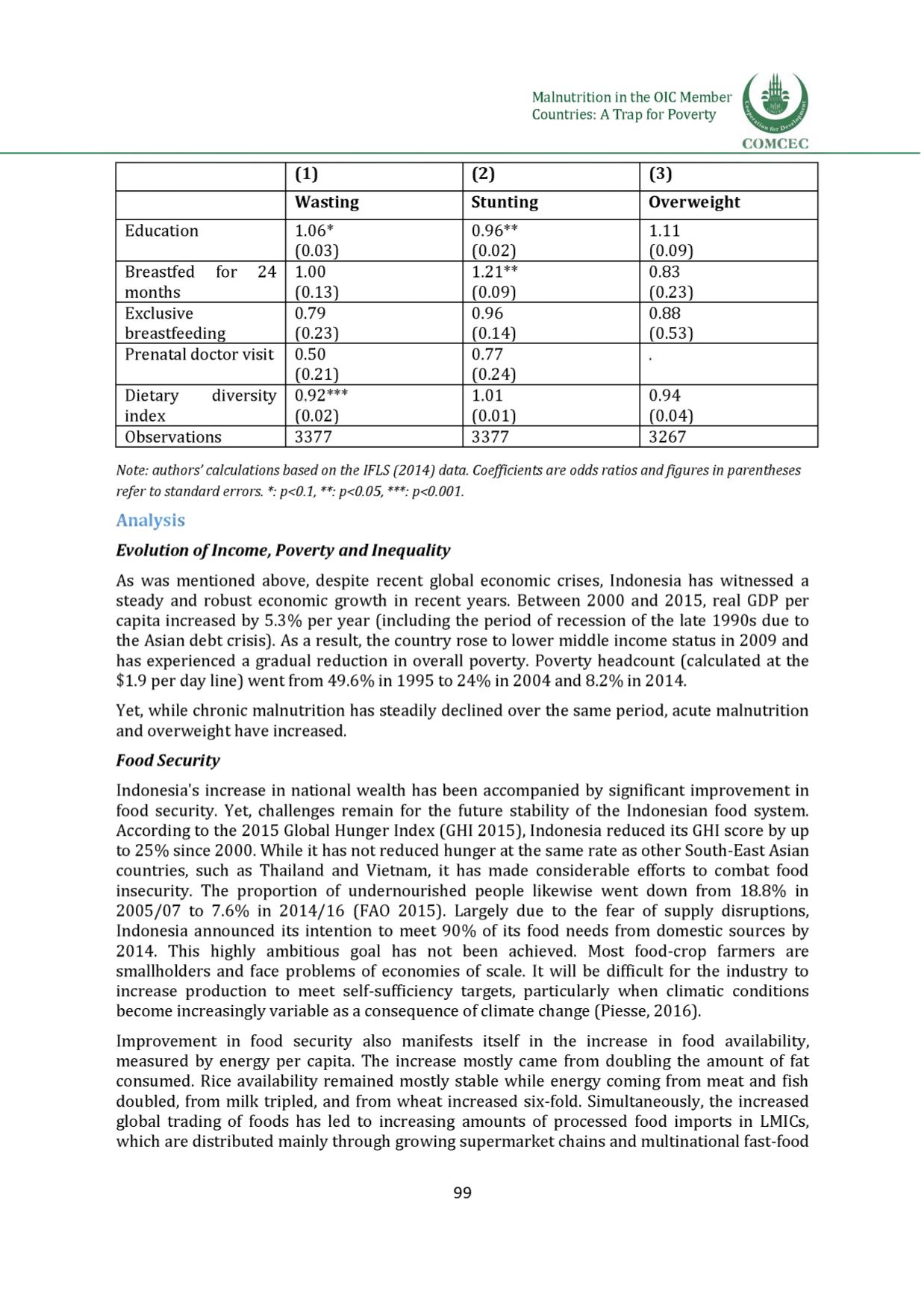

Malnutrition in the OIC Member
Countries: A Trap for Poverty
COMCEC
(
1
)
(
2
)
(3)
Wasting
Stunting
Overweight
Education
1.06*
0.96**
1 . 11
(0.03]
(
0
.
0 2
]
(0.09]
Breastfed for 24
1. 00
1
.
2 1
**
0.83
months
(0.13]
(0.09]
(0.23]
Exclusive
0.79
0.96
0 . 8 8
breastfeeding
(0.23]
(0.14]
(0.53]
Prenatal doctor visit 0.50
0.77
(
0
.
2 1
]
(0.24]
Dietary
diversity 0
9 2
***
1 . 01
0.94
index
(
0
.
0 2
]
(
0
.
0 1
]
(0.04]
Observations
3377
3377
3267
Note: authors' calculations based on the IFLS (2014) data. Coefficients are odds ratios andfigures in parentheses
refer to standard errors. *: p<0.1, **: p<0.05, ***: p<0.001.
Analysis
Evolution of Income, Poverty and Inequality
As was mentioned above, despite recent global economic crises, Indonesia has witnessed a
steady and robust economic growth in recent years. Between 2000 and 2015, real GDP per
capita increased by 5.3% per year (including the period of recession of the late 1990s due to
the Asian debt crisis]. As a result, the country rose to lower middle income status in 2009 and
has experienced a gradual reduction in overall poverty. Poverty headcount (calculated at the
$1.9 per day line] went from 49.6% in 1995 to 24% in 2004 and 8.2% in 2014.
Yet, while chronic malnutrition has steadily declined over the same period, acute malnutrition
and overweight have increased.
Food Security
Indonesia's increase in national wealth has been accompanied by significant improvement in
food security. Yet, challenges remain for the future stability of the Indonesian food system.
According to th
e 2015 Global Hunger Index (GHI 2015], Indonesia reduced its GHI score by up
to 25% since 2000. While it has not reduced hunger at the same rate as other South-East Asian
countries, such as Thailand and Vietnam, it has made considerable efforts to combat food
insecurity. The proportion of undernourished people likewise went down from 18.8% in
2005/07 to 7.6% in 2014/16 (FAO 2015]. Largely due to the fear of supply disruptions,
Indonesia announced its intention to meet 90% of its food needs from domestic sources by
2014. This highly ambitious goal has not been achieved. Most food-crop farmers are
smallholders and face problems of economies of scale. It will be difficult for the industry to
increase production to meet self-sufficiency targets, particularly when climatic conditions
become increasingly variable as a consequence of climate change (Piesse, 2016].
Improvement in food security also manifests itself in the increase in food availability,
measured by energy per capita. The increase mostly came from doubling the amount of fat
consumed. Rice availability remained mostly stable while energy coming from meat and fish
doubled, from milk tripled, and from wheat increased six-fold. Simultaneously, the increased
global trading of foods has led to increasing amounts of processed food imports in LMICs,
which are distributed mainly through growing supermarket chains and multinational fast-food
99
















